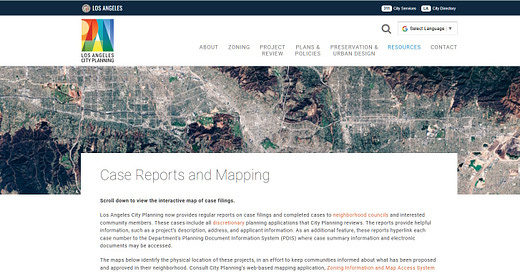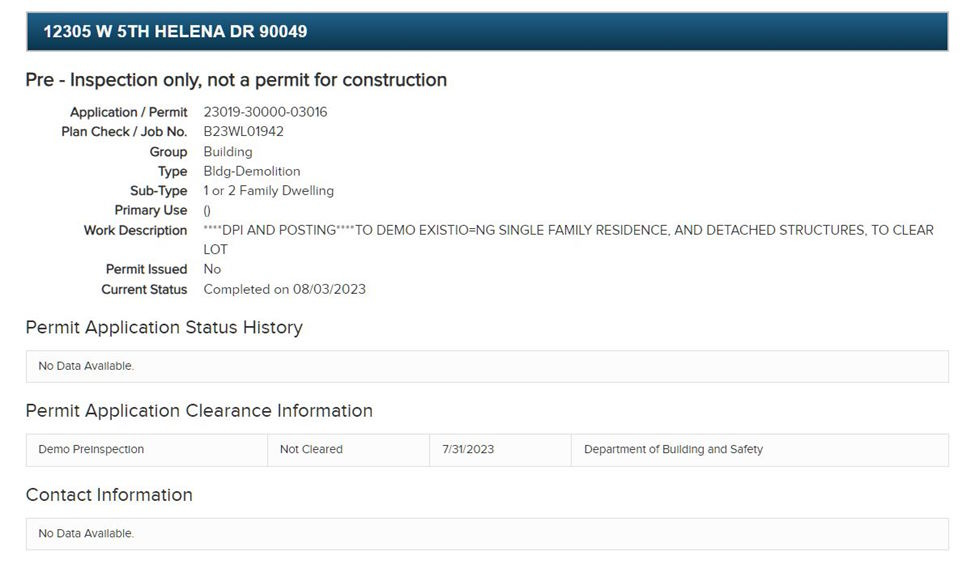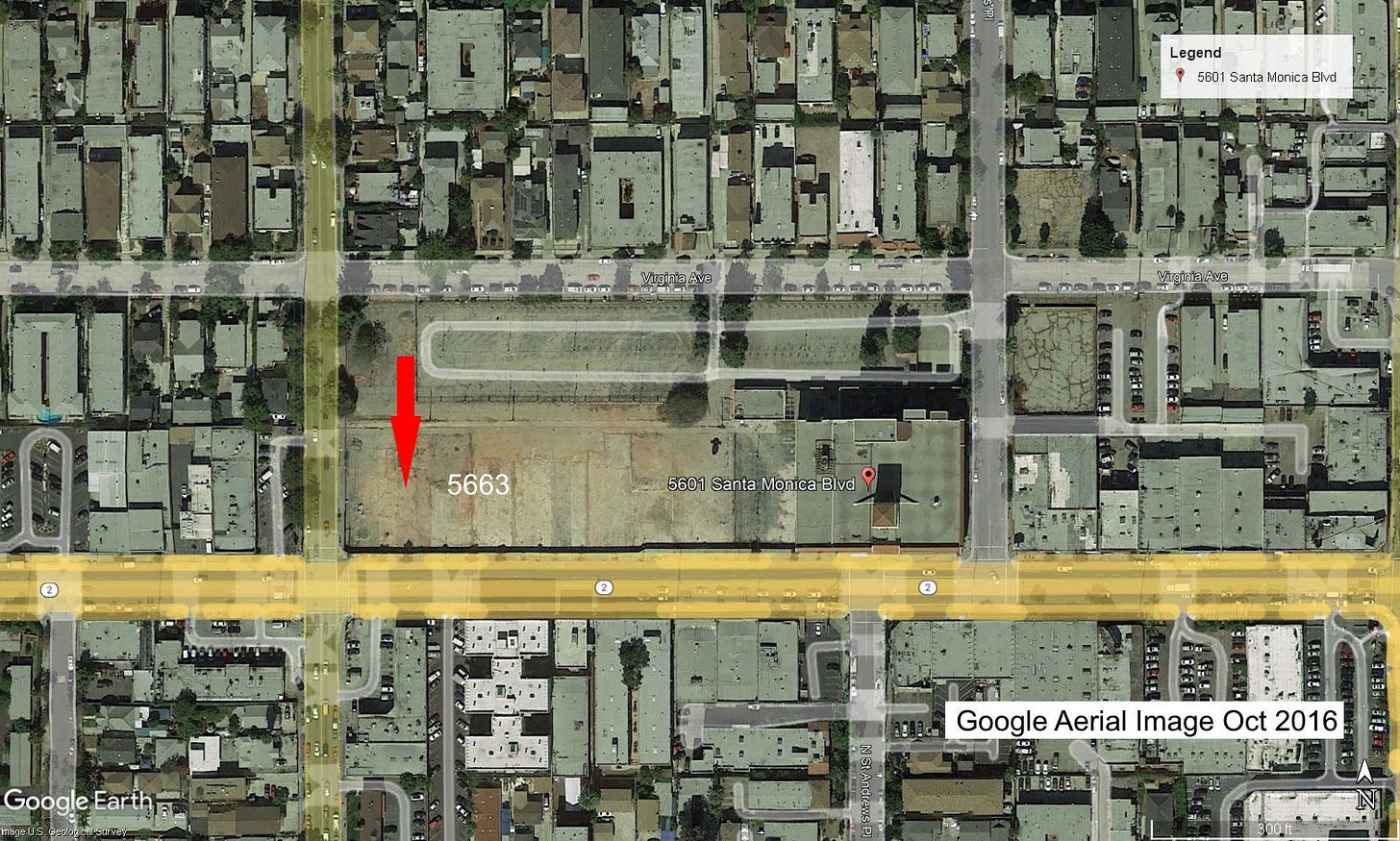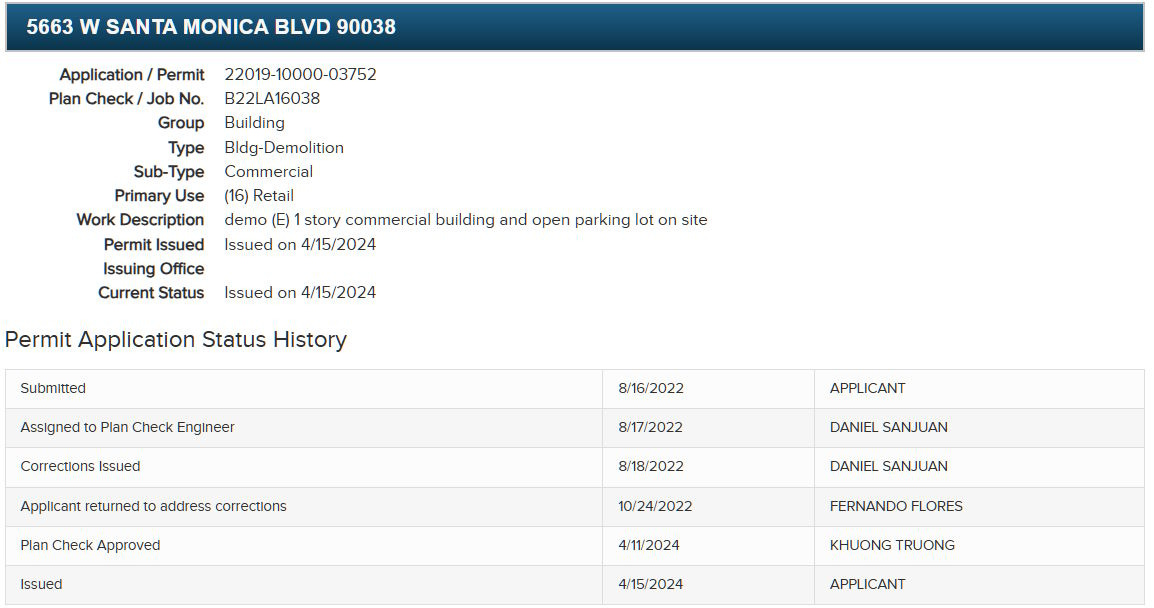THE DEMOLITION NOTIFICATION PROCESS
To Better Serve Both Developers and the Public, LADBS Needs to be Much More Transparent
Everywhere you look in Los Angeles, you’re likely to see a building being demolished for some new “in-fill” project. Many people may see the demolition fence going up and think nothing of it. Others may see the fence and become alarmed.
“What’s being built? What are we losing?” If the building is historic, or potentially historic, there may be sudden, large, and vocal outcry against the project. This may lead to the need for sudden Council action to halt demolition followed by subsequent legal action by the owner or developer. Such is the recent case with the proposed demolition of the Marilyn Monroe house in Brentwood.
Sadly, both public upset and the need for emergency action could be mostly avoided if the Los Angeles Department of Building and Safety (LADBS) were more transparent in managing the demolition permit process. The public has a right to know about pending demolitions and hiding them away from view, for whatever reason, does not serve the public or even the developer who must deal with the fallout. The following post addresses three main themes regarding ways to improve the current system:
Revise LACM 91.106.4.5.1 to improve the public notification process related to the issuance of LADBS demolition permits.
Improve the LADBS website (or provide a new website) so that people can easily find both pending and issued demolition permits for potentially historic buildings. The LADBS needs to overhaul their underlying database so that permits are assigned to the correct building address.
Both the Mayor and City Council should direct LADBS to stop being complicit in the destruction of potentially historic buildings by failing to provide timely notice to other city entities as required by law.
A. Public Notification of Demolition
The requirement to notify by mail abutting (neighboring) properties, and to post signage regarding pending demolition of a building 45 years or older, was enacted by City Ordinance 183312 in 2014. Added detail specifying the size and type of sign to be posted took effect in early 2020 with the approval of Ordinance 186484. The official requirements for obtaining a demolition permit for historic and cultural buildings are found in LAMC 91.106.4.5.
If the intent of the notification requirements is historic preservation (as implied by the age criteria), why limit the notification to abutting properties? These properties are most impacted by the physical demolition, but the emotional and cultural impact of the demolition goes far beyond. Historic and cultural buildings can connect people located throughout the local neighborhood, the city, the State, the Nation, and the world. A notification limited to only the abutting properties fails to acknowledge, and hides, the potential significance of the building to those who are impacted culturally and historically.
In addition, with regards to a neighborhood undergoing large-scale demolition, what use is mailing a notice to an occupant in an abutting property when that occupant has already been displaced? Or mailing notice to an address where the owner has already evicted the tenants? In this situation, there is no public to notify because the adjacent neighbors have already been removed, the neighborhood already destroyed. Thus, in this case, the notification serves no purpose whatsoever.
The posting of a notice solely at the physical site is inadequate for similar reasons. For example, the Marilyn Monroe house is located at the end of a cul-de-sac. The site is secluded and out of the way. No one walking along, or driving down, S Carmelina Ave would see a sign posted at the end of W 5th Helena Dr. Some people reported that no sign was posted. Was one put up and then removed? To what extent did the LADBS verify sign placement?
We know that the current notification requirements are inadequate since it took an emergency action by the City Council to halt demolition. A robust and effective notification process would provide all potentially impacted stakeholders sufficient time to respond and act. To provide timely and effective notice, I propose the following actions:
The party seeking a demolition permit should post public notice in the local press. The posting should run for a minimum of one week and serve as an announcement to the public that a demolition permit application is being filed. The LADBS should require the applicant to provide proof of publication as part of the application for demolition pre-inspection and posting.
Mail notification should include all property tenants and building owners located within 500 feet or more of the site. Notice should be mailed out at least 30 days prior to the approval of a demolition permit for a non-historic building and 90 days prior for a building 45 years or older.
The LADBS should include a list of all demolition permit applications in the bi-weekly entitlement reports. These reports are sent out to interested parties and they often contain information about pre-demolition inspections. Expanding coverage to include permit applications would provide the public with useful and timely data. The interested reader can sign up for entitlement reports by visiting the City Planning website under Resources/Case Reports.
B. Improve the LADBS Website
The LABDS maintains a website portal where one can obtain current building permits and their status, filed complaints and their status, and permits of historical interest. The website provides access to the different data systems used by LADBS to track and manage projects. Other websites provide access to building data via a geographical interface. Examples include the Building Information Online (BIO) system by LADBS, the Zone Information and Map Access System (ZIMAS) by City Planning, and Historic Places LA by the Office of Historic Resources.
One key feature, and potential limitation with regards to preservation use, is that all these sites rely upon the building address as the starting point. While this makes perfect sense for the LADBS and the permit applicant, various stakeholders need to know what is happening within their sphere of concern. The current website design is useful only after the fact, after the public learns that a given address is slated for demolition. If such notice happens at the end of the 30-day posting period, there may be too little time left to act.
A very useful feature would be a webpage that would allow for searching all applications for a demolition permit filed within a given geographic area and/or range of dates. Users would be able to set alerts based on screening criteria such as distance of demolition site from their home address or the location of all pending demolition sites within a given definable area. It might be useful to select demolition applications based on building age, or at least identify all of the buildings more than 45 years of age.
Another issue regarding the LADBS website is data quality. Very often, the presented data fields may be missing, incomplete, or out-of-date. The LADBS may not see the need for data accuracy as a major issue since they can always refer to the physical document, but the public can not access the actual application or permit and must rely upon this surrogate data.
The status is listed as “Completed on 08/03/2023.” The demolition pre-inspection status is listed as “Not Cleared, 7/31/2023.” This information is confusing and conflicting. The status of the application can not be completed until the pre-inspection has cleared. Either the entry for pre-inspection is out of date, or the status entry is in error. The user should not have to guess as to which entry is correct. Also notice that no contact information is presented. Someone filed the application, and the information is available, but the LADBS did not enter this data.
Another issue is the impact of address errors in the LADBS system. Complaints regarding illegal construction at the Pig ‘n Whistle Café (6714 Hollywood Blvd) were ignored because the LADBS assumed that the work was part of the project for the adjacent Egyptian Theater. A recent CEIS report I obtained clearly shows that LADBS continues to confuse 6714 Hollywood Blvd with the Egyptian Theater retail shops at 6710 and 6712 Hollywood Blvd. I highlighted the errors and sent them to the assigned inspector, only to be rebuffed and told to file a complaint. The only way I will know if, when, and how the report is corrected is by making repeated record requests.
An address error also impacted the recent demolition of the Sears Building on Santa Monica Blvd. While City Planning may use the address 5663 Santa Monica Blvd to denote the overall project site, the LADBS bases their actions on the specific address listed on the permit. Thus, a request to clear the Demolition Pre-Inspection and Posting for 5663 Santa Monica Blvd resulted in the LADBS inspector going out to the site and finding an empty lot.
The building at 5601 Santa Monica Blvd was not cleared by LADBS, but City Planning staff then cleared the permit for the demolition of a building that did not exist. Per the available record presented online, the demolition of 5601 Santa Monica Blvd was conducted without a permit. Demolition without a permit is illegal, even if it is due to a simple clerical error. The demolition contractor should have raised this issue with LADBS prior to commencing work.
C. Require LABDS to Provide Timely Information to City Entities
By law, the LADBS is required to notify via mail the local Council District Office and the Certified Neighborhood Council Office of all demolition notices for buildings 45 years or older within their respective jurisdiction. Indications are that these notifications seldom happen, hitting these officials by surprise when they are suddenly swamped by phone calls from agitated and concerned constituents seeking action. News reports were the first notice of approved demolition for the Marilyn Monroe house.
But, if early notification did occur, of what importance would the address 12305 W 5th Helena Dr have compared to any other demolition notice received for a similar building? How would a member of the Council office know that this house might deserve special attention? The current law does not require LADBS to conduct any form of assessment regarding historic importance.
At a minimum, the permit application should require the applicant to conduct a preliminary assessment of building history. The applicant should be required to review available LADBS permits and submit data regarding year of construction, architect, builder, and any character-defining features. An online search should be conducted to identify either major events or owners/occupants of note associated with the address.
Within a few minutes of performing a Google search, I found that 12305 W Helena Dr is listed on the Historic Places LA website. The address is given a classification code of QQQ (may be eligible, more research required). Such a finding should raise a flag that the LADBS should involve other city agencies such as the Office of Historic Resources. For the Marilyn Monroe property, no outside agency was contacted and asked to provide clearance.
LADBS’ reluctance to reach out to others also fails to utilize and take advantage of the large network of citizens who are interested and most willing to help. Often, members of Hollywood Heritage, The Art Deco Society, and the Los Angeles Conservancy assist OHR in the preparation of historic documentation. For any building 45 years or older, OHR should be included in the clearance process.
To not overwhelm the limited staff at OHR, I propose that an outreach program solicit input from all interested stakeholders. The same website that provides public notice of demolition permits could include a citizens’ forum. The forum would provide a place for people to collect and post relevant information for a given address. Then, upon a clearly defined closing date, OHR would review the data and render their decision to LADBS regarding clearance.
In Closing
I hope you agree with me that the City of Los Angeles can do a much better job in managing the notification process associated with the demolition of potentially historic buildings. Nothing proposed in this letter should be an undue burden to the city or permit applicant. Buildings found worthy of historic nomination must still go through the existing nomination and approval process. It is my hope and contention that a much more transparent system will eventually lead to a better outcome for all concerned.








Terrific recommendations! Maybe once the dust settles with the Marilyn matter, you can bring these ideas to CD 11 for a possible council motion.